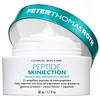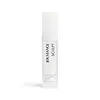What's inside
What's inside
 Key Ingredients
Key Ingredients

 Benefits
Benefits

 Concerns
Concerns

 Ingredients Side-by-side
Ingredients Side-by-side

Water
Skin ConditioningGlycerin
HumectantDimethicone
EmollientOlive Oil Decyl Esters
Glycereth-26
HumectantSqualane
EmollientButylene Glycol
HumectantBehenyl Alcohol
EmollientPolysilicone-11
Batyl Alcohol
EmollientSimmondsia Chinensis Seed Oil
EmollientHexapeptide-11
Skin ConditioningDipeptide Diaminobutyroyl Benzylamide Diacetate
Skin ConditioningPalmitoyl Tripeptide-5
Skin ConditioningTripeptide-10 Citrulline
Skin ConditioningAcetyl Hexapeptide-1
Skin ConditioningAcetyl Tetrapeptide-11
Skin ConditioningAcetyl Hexapeptide-8
HumectantPalmitoyl Hexapeptide-12
Skin ConditioningAcetyl Tetrapeptide-9
Skin ConditioningPalmitoyl Tetrapeptide-7
Skin ConditioningAcetyl Tetrapeptide-2
Skin ConditioningAcetyl Octapeptide-3
HumectantPalmitoyl Hexapeptide-19
Skin ConditioningTrifluoroacetyl Tripeptide-2
Skin ConditioningTripeptide-1
Skin ConditioningPalmitoyl Oligopeptide
CleansingPalmitoyl Tripeptide-1
Skin ConditioningNatto Gum
Sodium Polyglutamate
HumectantSqualene
EmollientMica
Cosmetic ColorantSodium Hyaluronate
HumectantSorbic Acid
PreservativeTocopherol
AntioxidantCereus Grandiflorus Flower Extract
Skin ConditioningPseudoalteromonas Ferment Extract
HumectantLeuconostoc/Radish Root Ferment Filtrate
AntimicrobialMagnesium Chloride
Phenoxyethanol
PreservativeCetyl Alcohol
EmollientStearyl Alcohol
EmollientTrehalose
HumectantGlyceryl Stearate
EmollientSilanetriol Trehalose Ether
EmollientMannitol
HumectantPhytosterols
Skin ConditioningAcrylates/C10-30 Alkyl Acrylate Crosspolymer
Emulsion StabilisingCaprylic/Capric Triglyceride
MaskingHydrogenated Lecithin
EmulsifyingPolyglyceryl-10 Myristate
Skin ConditioningPolysorbate 20
EmulsifyingDimethyl Isosorbide
SolventSodium Benzoate
MaskingPotassium Sorbate
PreservativeCaprylyl Glycol
EmollientSodium Hydroxide
BufferingLaureth-12
EmulsifyingHydrolyzed Wheat Protein
Skin ConditioningLecithin
EmollientDisodium Phosphate
BufferingHydrolyzed Soy Protein
HumectantCarbomer
Emulsion StabilisingDextran
Ethylhexylglycerin
Skin ConditioningSodium Lactate
BufferingTetradecyl Aminobutyroylvalylaminobutyric Urea Trifluoroacetate
Skin ConditioningSodium Phosphate
BufferingXanthan Gum
EmulsifyingTriethanolamine
BufferingAcrylates Copolymer
Water, Glycerin, Dimethicone, Olive Oil Decyl Esters, Glycereth-26, Squalane, Butylene Glycol, Behenyl Alcohol, Polysilicone-11, Batyl Alcohol, Simmondsia Chinensis Seed Oil, Hexapeptide-11, Dipeptide Diaminobutyroyl Benzylamide Diacetate, Palmitoyl Tripeptide-5, Tripeptide-10 Citrulline, Acetyl Hexapeptide-1, Acetyl Tetrapeptide-11, Acetyl Hexapeptide-8, Palmitoyl Hexapeptide-12, Acetyl Tetrapeptide-9, Palmitoyl Tetrapeptide-7, Acetyl Tetrapeptide-2, Acetyl Octapeptide-3, Palmitoyl Hexapeptide-19, Trifluoroacetyl Tripeptide-2, Tripeptide-1, Palmitoyl Oligopeptide, Palmitoyl Tripeptide-1, Natto Gum, Sodium Polyglutamate, Squalene, Mica, Sodium Hyaluronate, Sorbic Acid, Tocopherol, Cereus Grandiflorus Flower Extract, Pseudoalteromonas Ferment Extract, Leuconostoc/Radish Root Ferment Filtrate, Magnesium Chloride, Phenoxyethanol, Cetyl Alcohol, Stearyl Alcohol, Trehalose, Glyceryl Stearate, Silanetriol Trehalose Ether, Mannitol, Phytosterols, Acrylates/C10-30 Alkyl Acrylate Crosspolymer, Caprylic/Capric Triglyceride, Hydrogenated Lecithin, Polyglyceryl-10 Myristate, Polysorbate 20, Dimethyl Isosorbide, Sodium Benzoate, Potassium Sorbate, Caprylyl Glycol, Sodium Hydroxide, Laureth-12, Hydrolyzed Wheat Protein, Lecithin, Disodium Phosphate, Hydrolyzed Soy Protein, Carbomer, Dextran, Ethylhexylglycerin, Sodium Lactate, Tetradecyl Aminobutyroylvalylaminobutyric Urea Trifluoroacetate, Sodium Phosphate, Xanthan Gum, Triethanolamine, Acrylates Copolymer
Water
Skin ConditioningButylene Glycol
HumectantDicaprylyl Carbonate
EmollientCetearyl Isononanoate
EmollientGlycerin
HumectantCeteareth-20
CleansingCetearyl Alcohol
EmollientGlyceryl Stearate
EmollientCeteareth-12
EmulsifyingCetyl Palmitate
EmollientSorbitan Laurate
EmulsifyingHydroxyethylcellulose
Emulsion StabilisingAcetyl Dipeptide-1 Cetyl Ester
Skin ConditioningAvena Sativa Kernel Extract
AbrasiveDimer Tripeptide-43
Acrylates/C10-30 Alkyl Acrylate Crosspolymer
Emulsion StabilisingXanthan Gum
EmulsifyingDisodium EDTA
Sodium Hydroxide
BufferingRicinus Communis Seed Oil
MaskingCitrus Aurantium Dulcis Peel Oil
MaskingCitrus Nobilis Peel Oil
MaskingCitrus Aurantium Bergamia Fruit Oil
Masking3-Hexenol
MaskingCarum Carvi Seed Oil
MaskingLavandula Angustifolia Oil
MaskingPelargonium Graveolens Flower Oil
MaskingMenthol
MaskingPhenoxyethanol
PreservativeEthylhexylglycerin
Skin ConditioningWater, Butylene Glycol, Dicaprylyl Carbonate, Cetearyl Isononanoate, Glycerin, Ceteareth-20, Cetearyl Alcohol, Glyceryl Stearate, Ceteareth-12, Cetyl Palmitate, Sorbitan Laurate, Hydroxyethylcellulose, Acetyl Dipeptide-1 Cetyl Ester, Avena Sativa Kernel Extract, Dimer Tripeptide-43, Acrylates/C10-30 Alkyl Acrylate Crosspolymer, Xanthan Gum, Disodium EDTA, Sodium Hydroxide, Ricinus Communis Seed Oil, Citrus Aurantium Dulcis Peel Oil, Citrus Nobilis Peel Oil, Citrus Aurantium Bergamia Fruit Oil, 3-Hexenol, Carum Carvi Seed Oil, Lavandula Angustifolia Oil, Pelargonium Graveolens Flower Oil, Menthol, Phenoxyethanol, Ethylhexylglycerin
Ingredients Explained
These ingredients are found in both products.
Ingredients higher up in an ingredient list are typically present in a larger amount.
Acrylates/C10-30 Alkyl Acrylate Crosspolymer is a synthetic polymer. It is used to thicken and improve the texture of products. Due to its properties, it can prevent water and oil ingredients from separating.
Butylene Glycol (or BG) is used within cosmetic products for a few different reasons:
Overall, Butylene Glycol is a safe and well-rounded ingredient that works well with other ingredients.
Though this ingredient works well with most skin types, some people with sensitive skin may experience a reaction such as allergic rashes, closed comedones, or itchiness.
Learn more about Butylene GlycolEthylhexylglycerin (we can't pronounce this either) is commonly used as a preservative and skin softener. It is derived from glyceryl.
You might see Ethylhexylglycerin often paired with other preservatives such as phenoxyethanol. Ethylhexylglycerin has been found to increase the effectiveness of these other preservatives.
Glycerin is already naturally found in your skin. It helps moisturize and protect your skin.
A study from 2016 found glycerin to be more effective as a humectant than AHAs and hyaluronic acid.
As a humectant, it helps the skin stay hydrated by pulling moisture to your skin. The low molecular weight of glycerin allows it to pull moisture into the deeper layers of your skin.
Hydrated skin improves your skin barrier; Your skin barrier helps protect against irritants and bacteria.
Glycerin has also been found to have antimicrobial and antiviral properties. Due to these properties, glycerin is often used in wound and burn treatments.
In cosmetics, glycerin is usually derived from plants such as soybean or palm. However, it can also be sourced from animals, such as tallow or animal fat.
This ingredient is organic, colorless, odorless, and non-toxic.
Glycerin is the name for this ingredient in American English. British English uses Glycerol/Glycerine.
Learn more about GlycerinGlyceryl Stearate is a mix of glycerin and stearic acid.
It is used to stabilize the mixing of water and oil ingredients. By preventing these ingredients from separating, it can help elongate shelf life. It can also help thicken the product's texture.
As an emollient, it helps soften skin and supports barrier-replenishing ingredients.
In cosmetics, Glyceryl Stearate is often made from vegetable oils or synthetically produced.
This ingredient may not be fungal-acne safe
Fun fact: The human body also creates Glyceryl Stearate naturally.
Learn more about Glyceryl StearatePhenoxyethanol is a preservative that has germicide, antimicrobial, and aromatic properties. Studies show that phenoxyethanol can prevent microbial growth. By itself, it has a scent that is similar to that of a rose.
It's often used in formulations along with Caprylyl Glycol to preserve the shelf life of products.
Sodium Hydroxide is also known as lye or caustic soda. It is used to adjust the pH of products; many ingredients require a specific pH to be effective.
In small amounts, sodium hydroxide is considered safe to use. However, large amounts may cause chemical burns due to its high alkaline.
Your skin has a natural pH and acid mantle. This acid mantle helps prevent harmful bacteria from breaking through. The acid mantle also helps keep your skin hydrated.
"Alkaline" refers to a high pH level. A low pH level would be considered acidic.
Learn more about Sodium HydroxideWater. It's the most common cosmetic ingredient of all. You'll usually see it at the top of ingredient lists, meaning that it makes up the largest part of the product.
So why is it so popular? Water most often acts as a solvent - this means that it helps dissolve other ingredients into the formulation.
You'll also recognize water as that liquid we all need to stay alive. If you see this, drink a glass of water. Stay hydrated!
Learn more about WaterXanthan gum is used as a stabilizer and thickener within cosmetic products. It helps give products a sticky, thick feeling - preventing them from being too runny.
On the technical side of things, xanthan gum is a polysaccharide - a combination consisting of multiple sugar molecules bonded together.
Xanthan gum is a pretty common and great ingredient. It is a natural, non-toxic, non-irritating ingredient that is also commonly used in food products.
Learn more about Xanthan Gum